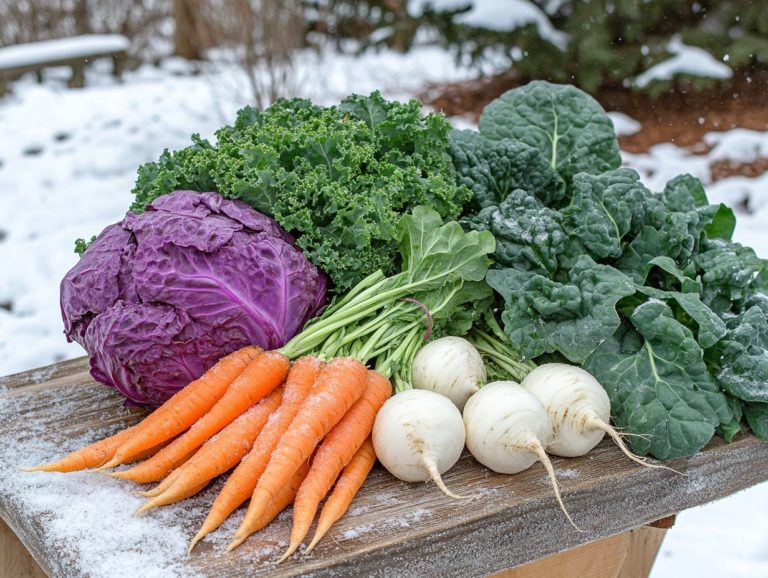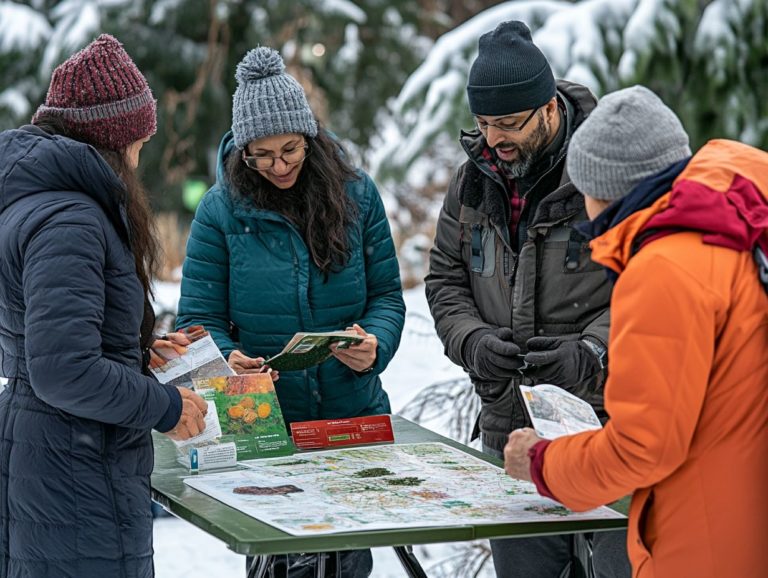Top 5 Cold-Climate Plants for Beginners
When it comes to gardening in colder climates, you might feel like your options are limited. However, many stunning and resilient plants thrive in chilly conditions, infusing your winter landscape with vibrant color and life.
This guide showcases the top five cold-climate plants perfect for beginners, including delightful pansies, charming snowdrops, and graceful winter jasmine. It also offers essential care tips, covering ideal locations, soil conditions, watering schedules, and common pests you might encounter. You will also find important tips on plant hardiness and selecting flowers.
Discover how cultivating these hardy plants can revolutionize your outdoor space, even in winter! With the right gardening methods, you can create a vibrant and thriving garden.
Contents
- Key Takeaways:
- 1. Pansies
- 2. Snowdrops
- 3. Winter Jasmine
- 4. Hellebores
- 5. Winterberry Holly
- How to Care for Cold-Climate Plants?
- Frequently Asked Questions
- What are the top 5 cold-climate plants for beginners?
- How do I care for conifers in cold climates?
- What makes hellebores a good choice for beginners in cold climates?
- Can I plant pansies in the ground in cold climates?
- What are some cold-climate succulents that are easy for beginners?
- Can I grow kale in a cold climate?
Key Takeaways:

- Pansies are a colorful and easy-to-grow cold-climate plant, perfect for beginners.
- Snowdrops are hardy and low-maintenance, making them a great choice for cold climates.
- Hellebores are shade-tolerant and can add pops of color to a winter garden.
1. Pansies
Pansies, with their vibrant hues and remarkable resilience, are an exceptional choice for gardeners in cold climate regions. They offer an impressive selection for gardens in USDA Zones, which indicate how well plants can survive in different climates, like 3B, particularly in places such as Saskatoon, Saskatchewan.
These hardy flowers thrive in various varieties, flourishing even when temperatures dip. This makes them perfect for winter planting.
Common types, such as the pansy that comes back every year and viola, do require some winter protection to ensure their survival. A layer of mulch around the base can insulate the roots and shield them from harsh winds.
When you plant pansies, aim for well-draining soil and consider raised beds to prevent waterlogging, which is crucial during the frigid months. If container gardening is more your style, opting for frost-resistant pots allows for flexibility and visual appeal in a winter garden.
Remember that proper care involves regular watering and deadheading to encourage blooming throughout the colder season.
2. Snowdrops
Snowdrops are truly exquisite perennial flowers that flourish in cold climates. They present an ideal choice for those who seek hardy plants that bloom early in the spring.
These delicate blossoms emerge triumphantly from the remnants of winter snow, showcasing remarkable resilience that allows them to endure harsh weather conditions. You’ll find they thrive best in well-drained, fertile soil enriched with organic matter, which helps establish robust root systems.
Their adaptability to various microclimates whether nestled in shaded woodland gardens or basking in sunnier spots makes them a remarkably versatile addition to any garden, especially in regions known for their unique climate challenges.
Not only do snowdrops bring beauty and brightness as one of the first harbingers of spring, but their natural charm also enhances the variety of plants and animals, providing early nourishment for pollinators that have just awoken from their winter slumber.
3. Winter Jasmine
Winter Jasmine, with its cheerful yellow blooms, is a resilient plant that thrives in cold climate gardens. It offers an appealing selection of early spring flowers that local gardeners cherish.
Its sprawling, vine-like growth habit injects vibrant color into the bleak winter landscape and makes it an excellent option for ground cover or as a climbing framework.
To unlock its full potential, you should pay particular attention to its care requirements, including providing well-drained soil and making sure it gets either full sun or partial shade.
Incorporating winter jasmine into your garden design can create stunning contrasts against evergreen foliage, adding visual interest especially when positioned near pathways or fences.
By selecting the right companion plants that bloom at different times, you can ensure a continuous display of color throughout the seasons.
Start planting these amazing shrubs for cold-climate gardens today and watch your garden come alive this winter!
4. Hellebores

Hellebores are a stunning addition to any cold climate garden. These hardy plants produce unique blooms that stand up to harsh winters with little protection.
They come in various species, like the Lenten rose (Helleborus orientalis) and the Christmas rose (Helleborus niger). Each showcases vibrant colors and intricate shapes.
To help them thrive, provide well-drained, nutrient-rich soil. Adding organic matter improves moisture retention, adapting these plants to local conditions.
In regions like USDA Zone 3B, soil conditions are crucial. Well-draining soil prevents root rot and allows these magnificent plants to flourish throughout the season.
5. Winterberry Holly
Winterberry Holly is a resilient plant perfect for cold climates. Its vibrant berries attract wildlife and create stunning winter displays.
This shrub grows best in moist, acidic soil. Be sure to plant both male and female varieties for abundant berries!
Watch for pests like aphids and scale, as well as diseases like leaf spot. Use organic methods to keep your plants healthy.
Including Winterberry Holly in your garden not only enhances beauty but also supports local ecosystems by providing food for birds.
How to Care for Cold-Climate Plants?
Caring for cold-climate plants involves specific techniques to ensure their survival in harsh winters, especially in USDA Zones like 3B. Understanding local weather patterns is essential.
Start with proper soil preparation. Make sure your soil is well-drained and rich in organic matter to boost plant health.
Choose plant varieties with strength against cold. This increases the chance they’ll survive the frigid months. For more guidance, check out these top tips for planting in cold climates and mix in some annuals and biennials for variety!
Winter protection techniques are vital. Mulching insulates roots, and evergreen shrubs act as windbreaks against harsh weather.
What Are the Best Locations for These Plants?
Choosing the best locations for your cold-climate plants requires understanding microclimates. This helps optimize sunlight exposure while shielding them from harsh winds. If you’re looking for inspiration, consider exploring the top 5 cold-weather crops you should try.
Notice the areas that receive different sunlight throughout the day. Also, identify cooler spots in the shade of structures or other plants.
Use this knowledge to place delicate flowers in sunnier areas and hardier species in cooler spots. Keep an eye on natural wind patterns for creating protective barriers like hedges.
What Soil Conditions Do These Plants Prefer?

Cold-climate plants thrive in specific soil conditions. For those looking to enhance their gardens, exploring the top 5 ground covers for cold climates can be beneficial. Achieving this balance requires careful soil preparation.
Ensure that drainage and nutrient retention work together. This supports a variety of plants, including vegetables and herbs suited for colder climates.
To help them grow, it’s essential to understand soil additives. Adding organic matter, like compost, enriches soil and improves its structure.
Regularly check the soil’s pH levels. This affects nutrient availability, and you can find simple testing kits at your local gardening store.
When mixing organic materials, combine well-rotted manure, leaf mold, and peat moss. This creates a rich planting medium that retains moisture while allowing for proper drainage.
These conditions promote healthy root development, ensuring your cold-climate plants thrive.
How Often Should These Plants Be Watered?
Understanding how often to water your cold-climate plants is essential for keeping them healthy, especially during thaw periods when their needs can change compared to summer.
These plants thrive in unique environments where soil temperature and moisture levels can vary greatly. Regularly evaluate your watering routine based on your specific climate zones, considering rainfall, humidity, and sunlight exposure.
Watch for signs of over-watering, like yellowing leaves or a soggy soil surface. Under-watering can show up as wilting leaves or dry, cracked soil.
To maintain optimal moisture levels, use mulch to help retain soil moisture. Always check the soil’s moisture content before watering to strike the perfect balance.
What Are the Common Pests and Diseases for These Plants?
Cold-climate plants, while impressively resilient, are not immune to common pests and diseases that can threaten their health. This requires your vigilant attention to gardening tips and the selection of colorful shrubs for cold climates as well as proactive winter protection measures.
Fluctuating temperatures and increased moisture can create prime conditions for problems like powdery mildew and aphid infestations. To combat these challenges, embrace preventative strategies, such as maintaining good sanitation practices, rotating your crops, and choosing disease-resistant varieties.
You can incorporate organic gardening solutions like neem oil or insecticidal soap to manage pests effectively without disrupting the delicate ecosystem. You can also foster beneficial insects, such as ladybugs and lacewings, to help maintain balance in your garden.
What Are the Benefits of Growing Cold-Climate Plants?
Growing cold-climate plants offers a wealth of benefits, from enhancing biodiversity to supporting local ecosystems. For instance, consider incorporating the top 5 pest-resistant plants for cold climates to create a vibrant garden that thrives despite challenging conditions!
These resilient species are essential for attracting vital pollinators like bees and butterflies, which maintain a balanced ecosystem. By choosing native varieties that flourish in cooler temperatures, you create a habitat that sustains wildlife and promotes healthy soil.
Embracing sustainable gardening practices allows you to conserve water and reduce chemical use, fostering a sense of community among fellow gardeners. As you cultivate your landscape, you actively contribute to preserving local flora and fauna, ensuring the beauty of nature endures for generations.
Frequently Asked Questions

What are you excited to plant this season?
What are the top 5 cold-climate plants for beginners?
The top five cold-climate plants for beginners are conifers, hellebores, pansies, hardy succulents, and kale. You’ll love how easy they are to care for, and for those interested in shade options, check out the top 5 shade-tolerant plants for cold climates that can also withstand colder temperatures.
How do I care for conifers in cold climates?
Conifers are hardy plants that thrive in cold climates. They need well-draining soil, regular watering especially during their first year and a protective layer of mulch around their base to keep the roots warm.
What makes hellebores a good choice for beginners in cold climates?
Hellebores are easy to care for and can thrive even in the cold. They are drought-tolerant and bloom in winter, adding beautiful colors to your garden.
Can I plant pansies in the ground in cold climates?
Yes! Pansies are perfect for cold climates. They tolerate frost and even snow, making them great for planting in early spring and fall. Just ensure they have well-draining soil and regular watering.
What are some cold-climate succulents that are easy for beginners?
Easy-to-grow hardy succulents for cold climates include hens and chicks, sedums, and ice plants. For those looking to expand their gardening skills, exploring the top 5 cold-weather vegetables for beginners can also provide options that survive freezing temperatures and require minimal maintenance—great for beginners!
Can I grow kale in a cold climate?
Absolutely! Kale is a cold-hardy vegetable, thriving in temperatures as low as 20 F. It s easy to grow and can yield multiple harvests in one season. Just provide well-draining soil and regular watering.
Get started on your gardening journey today with these fantastic plants!






